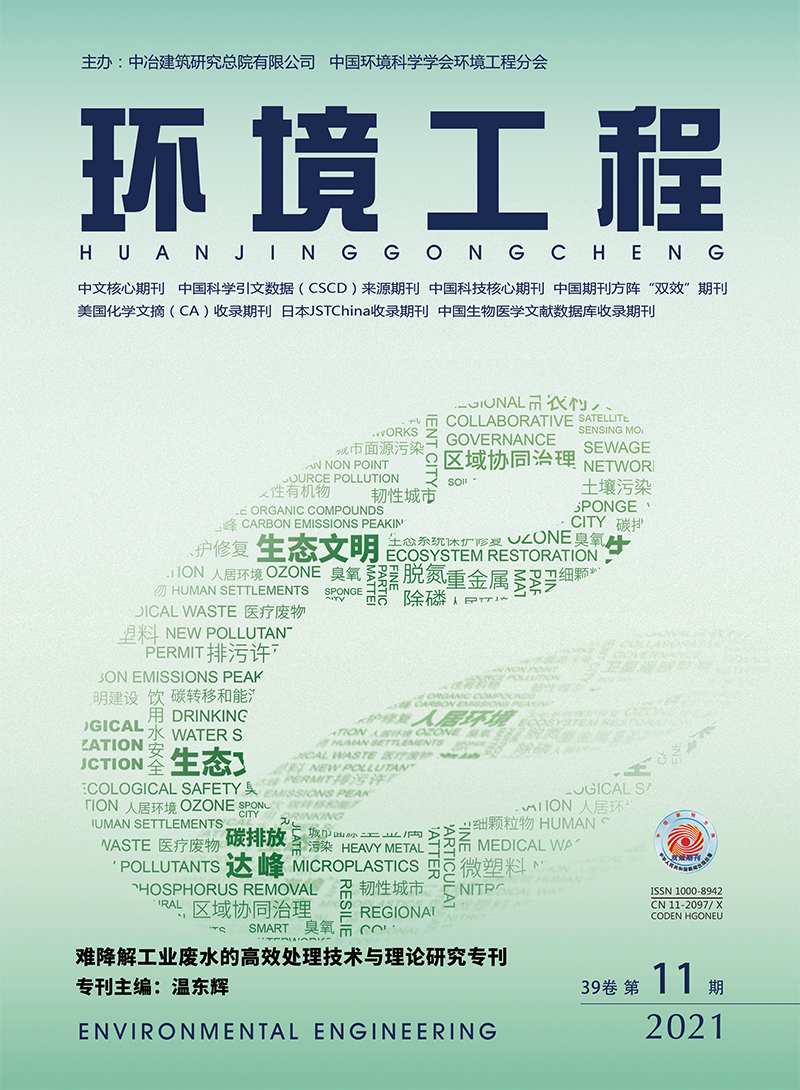| [1] |
GUIDO B, SILVIA B, CARLO R, et al. Technologies for the removal of phenol from fluid streams:a short review of recent developments[J]. Journal of Hazardous Materials, 2008, 160(2/3):265-288.
|
| [2] |
陈璐,曾韬,李竹,杨林.臭氧氧化技术在高浓度有机废水处理中的应用研究[J].环境工程, 2014, 32(增刊1):121-124,187.
|
| [3] |
严小平, 强弘. 臭氧的产生技术及应用[J].浙江树人大学学报(自然科学版), 2006, 6(1):33-37.
|
| [4] |
HU C Y, DU Y F, LIN Y L, et al. Kinetics of iohexol degradation by ozonation and formation of DBPs during post-chlorination[J]. Journal of Water Process Engineering, 2020,35:101200.
|
| [5] |
PAPAGEORGIOUS A, STYLIANOU S K, KAFFES P,et al. Effects of ozonation pretreatment on natural organic matter and wastewater derived organic matter-Possible implications on the formation of ozonation by-products[J]. Chemosphere, 2017, 170:33-40.
|
| [6] |
KLAVARIOTI M, MANTZAVINOS D, KASSINOS D. Removal of residual pharmaceuticals from aqueous systems by advanced oxidation processes[J]. Environment International, 2009, 35(2):1509-1518.
|
| [7] |
HOIGNÉ J, BADER H. The role of hydroxyl radical reactions in ozonation processes in aqueous solutions[J]. Water Research, 1976, 10(5):377-386.
|
| [8] |
HOIGNÉ J, BADER H. Rate constants of reactions of ozone with organic and inorganic compounds in water-Ⅰ:non-dissociating organic compounds[J]. Water Research, 1983, 17(2):173-183.
|
| [9] |
查晓松. 生物毒性检测技术在饮用水健康安全评价中应用的研究进展[J]. 科技创新与应用, 2019(29):175-176.
|
| [10] |
王士峰. 三维荧光技术在水质监测方面的应用与发展[J]. 山东工业技术, 2015(7):166.
|
| [11] |
ZHANG S, QUAN Y, SONG L,et al. Three-dimensional fluorescence characteristics of algal bio-oil[J]. Journal of Applied Spectroscopy, 2017, 84(3):508-511.
|
| [12] |
YANG G K, JONG H B, ALMA L M, et al. Efficient three dimensionalfluorescence measurements for characterization of binding properties in some plants[J]. Sensors and Actuators B:Chemical, 2017, 248:777-784.
|
| [13] |
YE Z, ZHAO Q L, ZHANG M H, et al. Acute toxicity evaluation of explosive wastewater bybacterial bioluminescence assays using a freshwater luminescent bacterium, Vibrio qinghaiensis sp. Nov.[J]. Journal of Hazardous Materials, 2011, 186(2/3):1351-1354.
|
| [14] |
MA M, TONG Z, WANG Z, et al. Acute toxicity bioassay using the freshwater luminescent Bacterium Vibrio-qinghaiensis sp. Nov.-Q67[J]. Bulletin of Environmental Contamination & Toxicology, 1999, 62(3):247-253.
|
| [15] |
SHANG N C, YU Y H, MA H W. Variation of toxicity during the ozonation of monochlorophenolic solutions[J]. Journal of Environmental Science and Health, Part A, 2002, 37(2):261-271.
|
| [16] |
HAN Q, DONG W Y, WANG H J, et al. Degradation of tetrabromobisphenol a by ozonation:performance, products, mechanism and toxicity[J]. Chemosphere, 2019, 235:701-712.
|
| [17] |
CHEN W, WESTERHOFF P, LEENHEER J A, et al. Fluorescence excitation-emission matrix regional integration to quantify spectra for dissolved organic matter[J]. Environment Science & Technology, 2003, 37(24):5701-5710.
|
| [18] |
RINNAN A, ANDERSEN C M. Handling of first-order Rayleigh scatter in PARAFAC modelling of fluorescence excitation-emission data[J]. Chemometrics and Intelligent Laboratory Systems, 2005, 76(1):91-99.
|
| [19] |
DUAN W Y, MENG F P, CUI H W, et al. Ecotoxicity of phenol and cresols to aquatic organisms:a review[J]. Ecotoxicology and Environmental Safety, 2018, 157:441-456.
|
| [20] |
HOIGNÉ J, BADER H. Rate constants of reactions of ozone with organic and inorganic compounds in water-Ⅱ:dissociating organic compounds[J]. Water Research, 1983, 17(2):185-194.
|
| [21] |
张彭义, 余刚, 蒋展鹏. 水中有机物与羟基自由基反应的QSAR分析[J]. 环境化学, 1999,18(3):232-237.
|
| [22] |
SERGEJ N, CLEMENS V S. Quantum chemical studies on the formation of ozone adducts to aromatic compounds in aqueous solution[J]. Ozone:Science & Engineering, 2010, 32(1):61-65.
|
| [23] |
JIANG J L, YUE X A, CHEN Q F, et al. Determination of ozonization reaction rateconstants of aromatic pollutants and QSAR study[J]. Bulletin of Environmental Contamintion and Toxicology, 2010,85:568-572.
|
| [24] |
BOROWSKA E, BOURGIN, HOLLENDER J, et al. Oxidation of cetirizine, fexofenadine and hydrochlorothiazide during ozonation:Kinetics and formation of transformation products[J]. Water Research, 2016, 94:350-362.
|
| [25] |
ELIZABETH A P L, ROBERT C C, MARCELO I G. Catechol oxidation by ozone and hydroxyl radicals at the air-water interface[J]. Environmental Science & Technology, 2014, 48(24):14352-14360.
|
| [26] |
PETER R. TENTSCHER, BOURGIN M, et al. Ozonation of para-substituted phenolic compounds yields p-benzoquinones, other cyclic α,β-unsaturated ketones, and substituted catechols[J]. Environmental Science & Technology, 2018, 52(8):4763-4773.
|
| [27] |
BOROWSKA E, BOURGIN M, HOLLENDER J, et al. Oxidation of cetirizine, fexofenadine and hydrochlorothiazide during ozonation:kinetics and formation of transformation products[J]. Water Research, 2016, 94:350-362.
|
| [28] |
TENTSCHER P R, MARC B AND URS V G. Ozonation of para-substituted phenolic compounds yields p-Benzoquinones, other cyclic α,β-unsaturated ketones, and substituted catechols[J]. Environmental Science & Technology, 2018, 52(8):4763-4773.
|
| [29] |
ROSSANA D V, TARA M S, NEIL V B. Contribution of quinones and ketones/aldehydes to the optical properties of humic substances (HS) and chromophoric dissolved organic matter (CDOM)[J]. Environmental Science & Technology, 2017, 51(23):13624-13632.
|
| [30] |
XIE P, ZHOU L, ZHANG Z, et al. Contribution to the reduction-induced fluorescence enhancement of natural organic matter:aromatic ketones outweigh quinones[J]. Luminescence, 2017, 32:1528-1534.
|
| [31] |
TARA M S, ROSSANA D V, MARLA B, et al. Combined effects of pH and borohydride reduction on optical properties of humic substances (HS):a comparison of optical models[J]. Environmental Science & Technology, 2019, 53(11):6310-6319.
|
| [32] |
SULZBERGER B, DURISCH-KAISER E. Chemical characterization of dissolved organic matter (DOM):a prerequisite for understanding UV-induced changes of DOM absorption properties and bioavailability[J]. Aquatic Sciences, 2009, 71:104-126.
|
| [33] |
WANG Y, MA J H. Quantitative determination of redoxactive carbonyls of natural dissolved organic matter[J]. Water Research, 2020, 185:116142.
|
| [34] |
MA J H, VECCHIO R D, KELLI S, et al. Optical properties of humic substances and CDOM:effects of borohydride reduction[J], Environmental Science & Technology, 2010, 44(14):5395-5402.
|


 Login
Login Register
Register E-alert
E-alert






 DownLoad:
DownLoad: